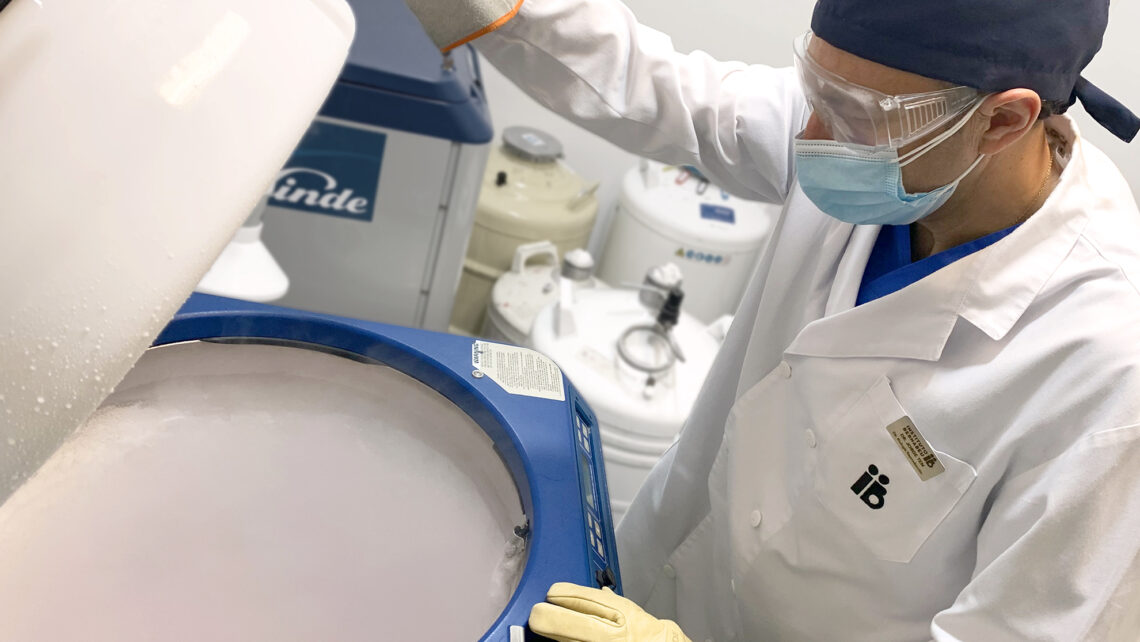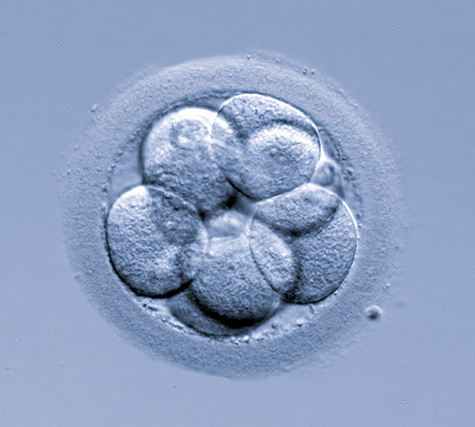
All you wish to know about embryo vitrification
Vitrification allows us to preserve embryos and have them in the future. This technique was incorporated into assisted reproduction and superseded the rest of cryopreservation techniques due to its simplicity and effectiveness.
Índice
- 1 Is there a difference between freezing, cryopreservation and vitrification?
- 2 What is the embryo vitrification about?
- 3 When should we vitrify embryos?
- 4 What are the advantages of embryo vitrification?
- 5 What is the best time to vitrify embryos and success rates?
- 6 Vitrification: performing the technique and different supports
- 7 Success rates of embryo vitrification
- 8 How long can embryos be cryopreserved?
Is there a difference between freezing, cryopreservation and vitrification?
In biological terms, we speak of freezing a cell or embryo, when keeping it at low temperatures in a latent state of suspended life. By paralyzing its physiological activity so that in the future it can be thawed and it can resume all its functions.
When we bring these cells or embryos to very low temperatures we speak of cryopreservation.
There’re different cryopreservation methods and they all have a common aim: to avoid the formation of ice crystals, as they damage the cell membrane structure causing its death or lysis. The cells are mostly water, so is a great challenge to overcome. One of these cryopreservation methods is vitrification.
What is the embryo vitrification about?
Vitrification is based on using a high concentration of cryoprotective molecules, which help dehydration of cells and, in combination with a rapid drop in temperature, form an amorphous solid state without crystal formation.
When should we vitrify embryos?
There’re many scenarios in which we have a good quality embryo in the IVF laboratory that will not be transferred to the mother’s uterus in that moment and can be vitrified so it can be transferred in the future. We vitrify embryos in the following scenarios, among others:
- If an embryo transfer is carried out and we have surplus of good quality embryos.
- When the transfer has been planned, but due to any factor, discourages making it at that time. For example, due to unexpected findings in the uterus at the time of transfer, inadequate hormonal levels, etc.
- If after ovarian stimulation there’s a high risk of developing an ovarian hyperstimulation syndrome. In these cases, we will postpone the transfer to the next cycle, eliminating all risk (deferred transfer).
- If at the time of transfer is impossible to access the uterine cavity.
- When we perform embryo biopsy for preimplantation genetic diagnosis (PGD). In these cases, the biopsied embryos are vitrified pending diagnosis.
- In double stimulation treatments, in which, after the eggs first collection, these are cryopreserved and a second stimulation is started a few days later. After the second collection, the egg from the first stimulation are devitrified to increase the number of available eggs and the in vitro fertilization treatment is carried out in which we will vitrify the embryos to carry out the transfer in the appropriate phase of the menstrual cycle.
- In an in vitro fertilization treatment with donated eggs where is not possible to synchronize the recipient’s uterus preparation with the ovarian stimulation of the egg donor. In some women, the use of hormones for the controlled preparation of the uterus is contraindicated and they must be transferred at the appropriate time in their menstrual cycle (natural cycle transfer) and this makes it difficult to synchronize with the donor. Having the option to cryopreserve the embryos for a later transfer in a natural cycle is possible thanks to vitrification.
- At times when external circumstances to the treatment prevent ending the treatment with an embryo transfer. A clear example was the situation experienced in March 2020 when the health emergency forced the activity of in vitro fertilization laboratories to be paralyzed. Since the scientific societies at that time advised to stop the assisted reproduction treatments that were underway due to the unknowledge of possible negative effects of Covid-19 during pregnancy.
What are the advantages of embryo vitrification?

Embryo vitrification provides great advantages to assisted reproduction.
- The first one is, from a single puncture we can perform several embryo transfers, which increases the chances of success per puncture, that is, the accumulated pregnancy rate.
- Embryo vitrification also provides safety in IVF treatments, as it allows postponement of transfers to avoid risks such as ovarian hyperstimulation.
- As we have several attempts to achieve pregnancy by puncture, we increasingly choose to transfer a single embryo. Therefore, embryonic vitrification helps reduce the number of multiple pregnancies, which carry greater risks for both the foetus and the mother.
- Another strength of cryopreserved embryo transfer is the simplicity of hormonal treatments for the patient compared to those required for ovarian stimulation. This means greater comfort for the patient and a much lower cost in medication. In some cases, it is done in what we call a “natural cycle”, which does not require any medication.
- Some studies have observed better results when transferring in a later cycle, after the cycle in which ovarian stimulation is performed, which produces a uterine environment that is not considered optimal. Focusing on preparing the uterus to achieve the best conditions is also a point in favour of embryo vitrification.
- Finally, as we can read above, for many different reasons, sometimes a fresh transfer cannot be made. In these cases, were it not for vitrification, there were people who could not complete their treatments, so we can say that in these cases embryonic vitrification is much more than an advantage, it is an open door, the way to achieve the desired pregnancy.
What is the best time to vitrify embryos and success rates?
Embryos can be vitrified on every stage of their development in the laboratory, although survival results and their potential to lead to pregnancy may vary depending on the day they were cryopreserved.
At the beginning of in vitro fertilization, we worked in the zygote stage (day 1 embryo, with a single cell) or in an embryo in the phase division (day 2 and day 3, embryos with 2 to 8 cells). However, the improvement in culture media and incubation equipment allowed the development of what we call “long culture”, which consists of keeping the embryos until day 5 or day 6 of culture so that they reach the blastocyst phase (embryo with around 200 cells). This allows us to better select the embryos (since we can rule out those that are not capable of reaching the blastocyst stage). In addition, it theoretically improves the synchronization of the embryo with the uterus, since in an in vivo conception the embryos do not reach the uterus until now. A great advantage of blastocyst culture is that blastocysts respond very well to vitrification.
But a crucial factor that will determine the chances of an embryo to survive thawing and to be able to lead to pregnancy is the embryo quality. There’re several criteria for the embryos’ classification. In the main classification systems, embryos can be grouped into four categories: A, B, C and D. Type A and type B are good quality embryos. Type C embryos are medium-low quality embryos and type D embryos are poor quality embryos with almost zero chances of generating pregnancy.
To support the vitrification and devitrification processes, an embryo must be of good quality. Therefore, the classification criteria must be applied correctly and good quality embryos selected to be frozen.
Vitrification: performing the technique and different supports
At present, there’re specific commercial means for eggs and embryo vitrification that have very simple protocols. The differences between the different commercial houses lie in the chosen cryoprotectants and their concentration, but in general the process is quite similar for all companies.
The technique development consists of passing the embryos through the different vitrification media and finally place it in a small amount of medium in a support that will be immersed in liquid nitrogen.
Is in the support type where we find differences. There’re open devices, in which the embryo comes into direct contact with liquid nitrogen in vitrification. In the devitrification process, it also comes into contact with the devitrification means, which allows a very rapid temperature rise (a key step for the survival of the embryo). But this direct contact with nitrogen during the storage time poses a theoretical risk of contamination. One of the best-known open devices is Kitazato’s Cryotop®.
To avoid contamination risks, is preferable to use closed devices that, with the appropriate design, also allow this rapid heating, so crucial in devitrification. Among the devices of this type we can find the high security VHS CBS straws from Cryo Bio System or the Cryotop® Closed System from Kitazato.
Success rates of embryo vitrification
When a powerful embryo cryopreservation program is available, such as the one developed at Instituto Bernabeu, vitrification offers us very high survival rates, with an average of 98%.
As we can see, devitrified embryos have a very high probability of resuming their state after thawing and offer very good probabilities of giving rise to pregnancy, depending of course on the specific case of each patient.
How long can embryos be cryopreserved?
At temperatures as low as the liquid nitrogen (-196ºC) in which embryos are stored, no chemical reactions take place. So the embryos remain in an invariable state indefinitely.
At the end of 2020, the news of the birth in October of little Molly in Tennessee (USA) travelled the whole planet. The little girl broke the record of being the embryo that had remained cryopreserved for the longest time and had resulted to birth, being transferred 27 years after its cryopreservation.
This gives us an idea of the potential that cryopreservation techniques have in assisted reproduction.
María Carmen Tió, biologist at Instituto Bernabeu
